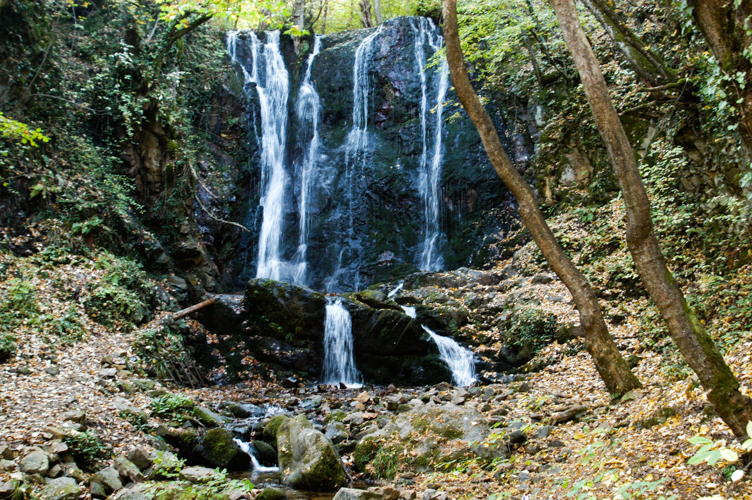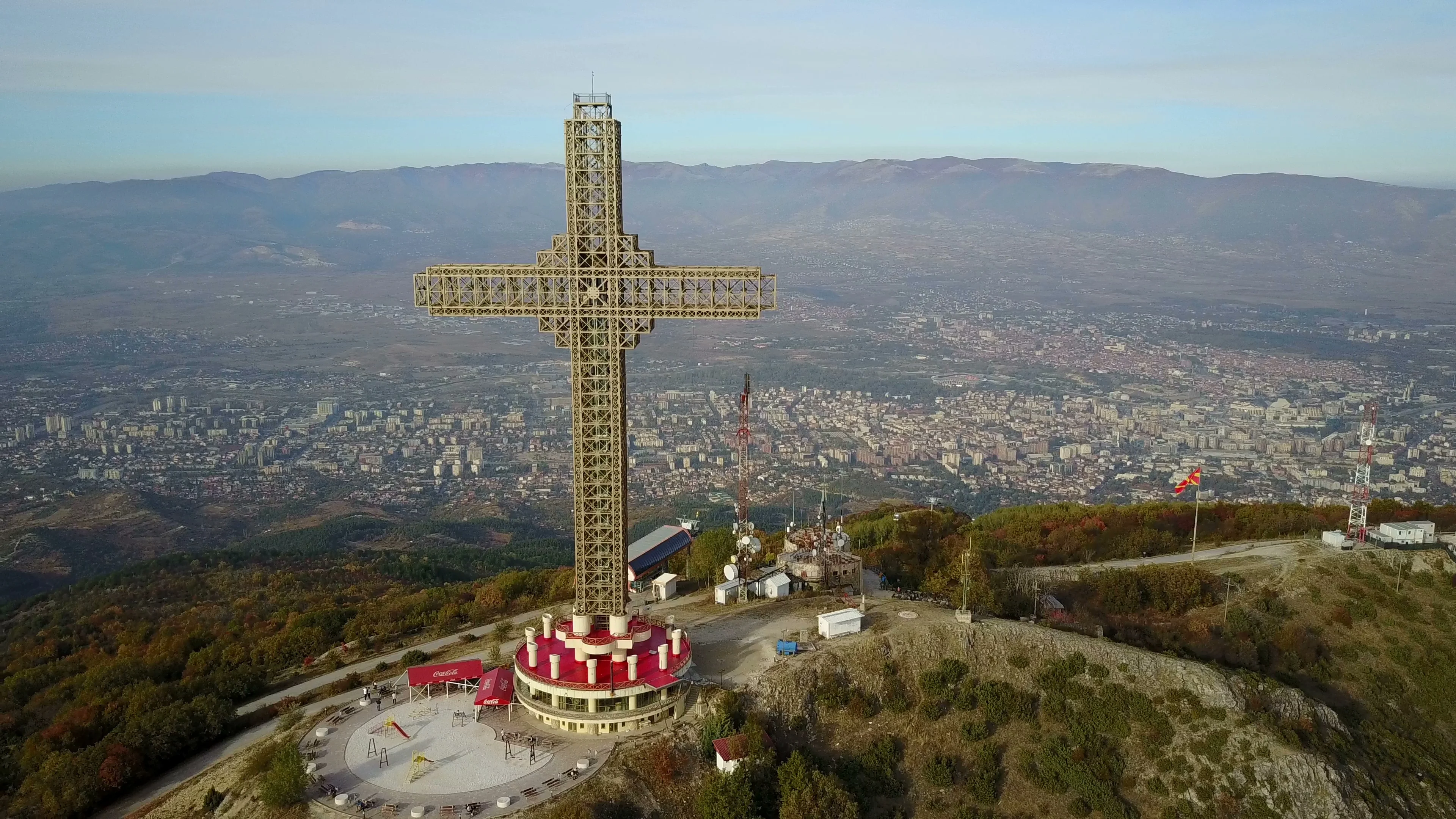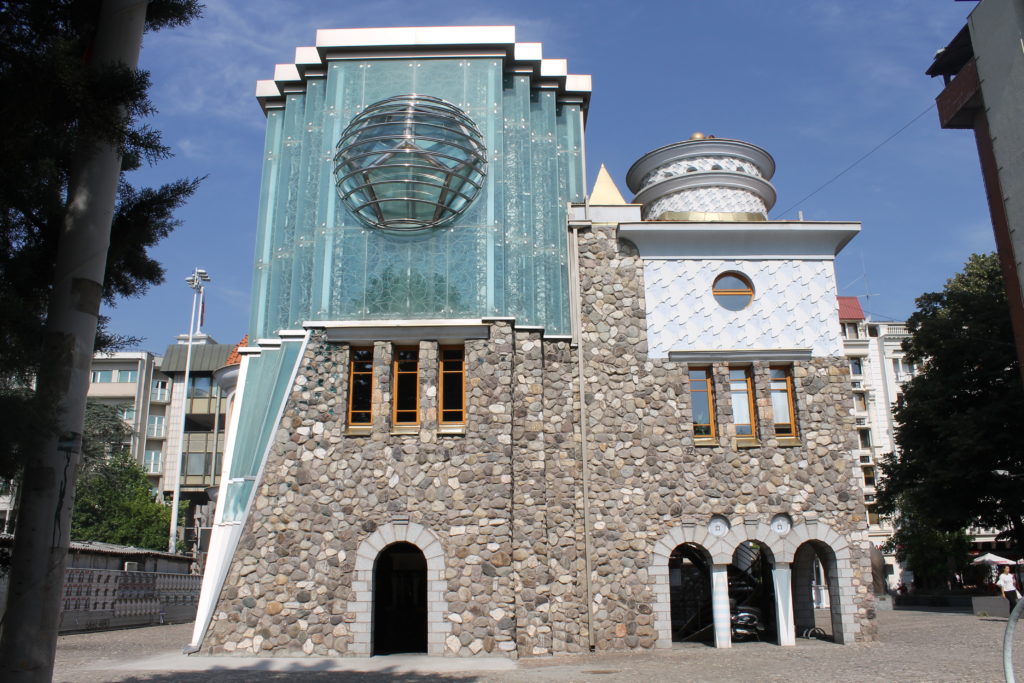North Macedonia – Pelagonia and West May 5-7 2019
I crossed the Bulgarian/North Macedonian border at 17:30 on May 5, 2019. It was painless on both sides. N Macedonia is easily the least problematic border to cross in the Balkans. I entered the extreme southeast of the country and saw both of these waterfalls (actually in North Macedonia north and east.
Smolare Falls. Only 11 km from the Bulgarian border, this is the highest waterfall in Bulgaria at 39.5m. It is on the Lemnitsa River deep in Mount Belasica at 630m elevation. After a day of rain, there was reasonable water flow.
Park and walk through the Atlantis Restaurant to start the trail. It is 550m long, a climb on good stone steps. The waterfall falls down a black granite face with white veining. There is no pool. I saw five gorgeous salamanders along the trail – a deep black, four with bright orange spots and one with bright yellow in a twisting strip along its back and spots.
Unfortunately, all the 14 or so garbage cans along the trail were overflowing with garbage strewn on the ground. Unbelievable. They should remove the cans and put up signs “Pack it in, Pack it out”.
Koleshino Waterfall. About 10 km west of Smolare, this 16m high waterfall is a wide cascade down mossy cliffs. The short 5-minute trail goes through a nice forest with many picnic tables and the same pile of garbage.

I then saw the places in North Macedonia West I had missed the first time and then drove to Skopje.
North Macedonia – Vardar and East May 7-8, 2019
Determined to see all of Skopje in one day, I was off early to see the several sights outside the city without opening times.
Unfortunately (or auspiciously) May 7 was the day Pope Francis I made the first visit of any pope to North Macedonia. The entire city was closed down with all the museums closed (for security reasons!) and streets in the downtown core blocked off. 2,700 policemen from all over N Macedonia were here for security with groups every 25 metres. Helicopters circled the city. People came from as far as Croatia (a mostly Christian country) to see him.
I found a parking place and tried to go down to the main square, the focal point of the visit. Security was extreme with complete bag searches and pat-downs. I was told I had to leave my umbrella at the checkpoint, returned to the van, got my computer electrical cord and rain jacket and returned to the square.
The crowds were huge. To enter the main square area, tickets had been available until May 3 and were by location in the square. The singing started at 11 am and the pope arrived in his pope mobile at about noon. He gave his homily and later a speech all in Italian (nobody understood a word), guests spoke and he left the same way. It was all anti-climactic and more than a little boring.
When I drove out of town to go to Kokino at 6 pm (hours after he had left the country), there were still cops every 50m for 10 km from the centre. The whole thing must have cost millions, money that could have been better spent in this poor country. And for a church rooted in the 15th century with beliefs so outdated as to make it meaningless: homosexuality, divorce, birth control, condoms, celibacy of priests (the root cause of priests sodomizing millions of little boys and for which this pope has done nothing) and the corruption rife through the church. I believe that civil lawsuits should be undertaken wherever this church exists, their land and buildings taken away and they bankrupted.
I had a walk about seeing all the things that were open.
SKOPJE
Stobi, About 5kms west of Skopje, was a NM “Sight” but I could not determine why, it looked like any N Macedonian city. There was an ancient synagogue from the 2nd century destroyed in the 5th century and a Christian church built on top here. It was also the site of the Roman town of Seripe.
Gradski Trgovski Center (City Trade Center). This large two-level shopping mall in the centre of Skopje occupies at least 2 city blocks. It has all the usual stores and 2 apartment buildings in the middle.
There are several great statues in and near the main square. A huge one to Alexander the Great is in the middle. A touching one with a mother stretching out for the hand of two children is near the mall.
Many restaurants with large covered outdoor seating line the west side of the river.
There are 4 bridges in central Skopje, three of them pedestrian. I crossed the traffic bridge covered in bronze plaques.
Art Bridge. Built in 2012, this marble bridge is decorated with 36 bronze statues of Macedonian artists, writers, composers and actors. It cost 2.5 million euros, is 83m long and 9.2m wide increasing to 12m in the centre and has lovely ornate lamp posts.

Mother Theresa Square. There are several plaques with her sayings: “Jesus said love one another, He didn’t say love the whole world”. “Smile at one another, smile at your wife, smile at your husband, smile at your children, smile at each other, it doesn’t matter who it is. And that will help to grow up in greater love for each other”. “Everything that is not given is lost”.
Sculpture Ensembles. There are many magnificent sculptures in the square on the east side of the river: Karposh Uprising (huge with soldiers and lions), Monument to St Cyrus and Methodius, one to motherhood (pregnant woman, a woman breastfeeding and two holding children), all the statues lining the marble wall along the east side of the river and two great fountains – one with horses and one with lions. The lovely Opera and Ballet theatre is also here.

Bridge of Civilization. Built in 2013, it has statues of distinguished people from Macedonia and around the world.
Stone Bridge. With 10 piers, three in the river, this is a wide modern-looking pedestrian bridge.
Holocaust Memorial Center for the Jews of Macedonia (Holocaust Museum of North Macedonia) in the NM “The Dark Side” series, this is a wonderful museum with a timeline of important world and Jewish events, videos (on the rise of the Nazi party and others) and exhibits on the expulsion of Jews from Spain in 1492 and Portugal in 1496 (many came to the Balkans and Turkey), great pieces with testimonies on 6 concentration camps (three of them “killing camps, especially Treblinka) in Poland, a box car, one of the diesel engines used to produce carbon monoxide and many others. I read and listened to every display. 100 MKD
Old Bazaar. On the east side of the square is this series of pedestrianized lanes with many cafes and shops with clothes and jewelry.
Sveti Spas Church (Church of the Ascension of Jesus, Church of the Holy Saviour). Built in the 14th century and destroyed by fire in 1689, the highlight is the masterful 1817-25 wood carved iconostasis. There is a museum to the revolutionary Gore Delchev in the basement.
Mustafa Pasha Mosque. Built of white limestone and marble, it has a 3-domed, 4-arched portico and is one huge dome inside with a grey mihrab and mimbar. Patterns of leaves decorate under the dome, around the windows and extend down the four corners. Free
Kale Fortress. Occupying the top of the hill, this has reconstructed bastion walls and 2 square towers but nothing can be entered and there is little to see. Free
As I finished my day early, I decided to drive east and north of Skopje to see a few sights there.
Archaeo-astronomical Site Kokino (Kokino megalithic observatory). A tentative WHS: (30/01/2009), this has evidence of activity dating from the Early Bronze Age (21st – 17th century), Middle Bronze Age (17th -14th centuries), late Bronze Age (14th -11th centuries) and the beginning of the Iron Age (11th -9th centuries) and is the only place in the world that served both as a religious sanctuary and an astronomical observatory. 70 km NE of Skopje, it is on Tatichev Komen Peak (1013m) above Kokino village. The people observed from four artificially carved platforms the solstices through cut marks in the rocks made at very precise locations. The moon, sun and star Aldebaran were all used in the calculations.
On top of the rugged mountain are a ruined sanctuary wall and 4 platforms, one with carved seats. A sign said tickets are 2€ for foreigners. I slept here and the temperature went down to 2°.
Kumanovo. In the NM “European Cities” series, it is between Skopje and Kikono
Kratovo. In the NM “small towns” series, it is southeast of Kikono.
Marko’s Monastery. A real drive about to get here (71 km from Kokino), this small 2-story monastery has a stone/brick church with frescoes painted on all the walls, arches and ceiling, great wood beams and an intricately carved cross on the iconostasis. 3 nuns were singing during mass. Free
VODNO MOUNTAIN (1,065m). This is the big mountain that looms over Skopje to the west. The Mount Vodno Cable Car (100 Den return) accesses the high point of the mountain at Millennium Cross. It is a 5km drive up here and Google Maps gives no indication on how to get to the base of the cable car. It operates only from 10 am with the last car at 19:30 up and last down at 19:45 (April to September, slightly shorter the rest of the year). The lower access is at 570m and the upper station is at 1,065m.
I had come up the day before at 8 am but didn’t want to wait around. So I returned and took the first car of the day.
Millennium Cross. At 66m, it is one of the highest crosses in the world, a symbol of the 2000-year history of Christianity. It is lit at night and can be seen from a huge distance. On top, there are several radio communication towers and a huge concrete tower is under construction. There is little to do but see the 360° panorama. One sign points to the south naming mountains but is only in Cyrillic. Snow-covered mountains line the horizon to the west. Skopje is down to the west.

Museum of the City of Skopje. On the site of the 1837 original train station (replaced in 1937), it has Roman sculpture and artifacts, ethnology, icons and details the magnitude six, 1963 earthquake that destroyed much of Skopje. Free
Memorial House of Mother Teresa. Mother Theresa (1910-96) was born Gendje Bojodjiu in Skopje. In 1929 she arrived in India and came to Calcutta two years later where she developed several clinics for the poor (Home of the Dying, Leprosy centre and others). She was a very decorated woman courted at various times by many world leaders: Nobel Peace Prize 1979, British Order of Merit 1983, US Presidential Medal of Freedom, Beautified at the Vatican 2003 (St Peter’s Square was completely packed) and in 2016, was declared a saint. The “house” had several photos of her life including many from her childhood. On the top floor is a lovely glass-walled chapel with a skylight dome. Free

Archaeological Museum of Macedonia. In a lovely building on the river between Mother Theresa Square and the Sculpture ensemble, the first floor has Roman sculptures and a huge numismatic collection. Free
The second floor has the usual artifacts from all the Ages and empires, including a few nice pieces of Roman gold. 200 MKD
Museum of the Macedonian Struggle. Detailing the 1904-5 original struggle against the Ottomans and the subsequent Balkan War, it finishes with exhibits on victims of the Communist regime. 300 MKD
National Gallery of Macedonia. In a lovely 2-sided Turkish bath with a huge dome and barrel-vaulted rooms, it was entirely the single exhibit entitled “Photography in Years” with some nice pieces and large-format slides hanging from the ceiling. 50 MKD
Museum of Macedonia. In a tired building, the history exhibit was under renovation. The three-floor ethnography section was more interesting than usual. I was the only one there. 60 Den
Museum of Contemporary Art. This huge gallery has some great exhibition spaces but almost no art – a photographic exhibit with an abstract bent and one called Freedom Space using wood models to show how architecture had improved some renovations of local buildings. Free
St. Clement of Ohrid. This round church is covered by a huge dome supported by 8 columns. It is frescoed completely. The huge iconostasis covers ⅓ of the room and has 36 icons on it.
Skopje Zoo. I don’t like zoos much – I think it is inhumane to lock up wild animals. This is a tired, old-fashioned zoo. The name of each animal was repeated in English but not the information. 50 MKD
Macedonian Museum of Natural History. This is a tired, old-fashioned NH museum, almost all with no English, with exhibits on rocks, some good mastodon/ancient mammal fossils, dried plants, insects, fish, birds, snakes, more birds and finally mammals. The highlight was the “dissected” fish and a rabbit. 60 MKD
Church of St. Panteleimon, Gorno Nerezi. On the slope of the east side of Vodno Mountain, this small monastery has an equally small church with moderately faded frescoes on all the walls and ceilings. This was my last “sight” in North Macedonia.
Caršija. A NM “Sight”, Google Maps took me to a place on the road very near the Kosovo border on the top of a mountain.
I crossed into Kosovo at about 5 pm. Again my car insurance was not valid here and it was necessary to purchase 15 days of insurance for €15. I also got the agent to take all the N Macedonian money I had as I never planned on returning to this country in the future.